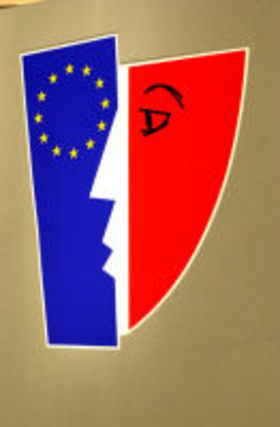Presidency of the Council

- French Presidency logo (Photo: French EU Presidency)
Presidency of the Council
The Council of ministers is led by a new President for the European Council and a presidency that is rotated between the EU member states every six months. The actual presidency works in a “troika” with the foregoing and the coming presidency.
The first appointed permanent President of the European Council was appointed in a special EU summit 19 December 2009. The Belgian Prime Minister, Herman Van Rompuy, got the job. A proposal to give the job to former British Prime Minister, Tony Blair, was rejected.
In 2014 the position was given to the Polish prime minister Donald Tusk in close competition with the Danish prime minister Helle Thorning-Schmidt.
The President prepares the meetings of the European Council. The new "foreign minister" Federica Mogherini heads the meetings of the foreign ministers from 2014. Other meetings are led by the rotating presidency.
They arrange and chair all the meetings of the Council and Council working groups. This gives the country holding the Presidency significant control over how often the Council and Council bodies meet, the items they discuss and what happens during the meetings.
Sweden has prepared 6,000 meetings in working groups and Council meetings for their 6-month presidency from 1 July 2009.
Notes
- In practice, the smaller EU countries have often run the best EU presidencies because they know they cannot focus upon their own interests while they hold the role. The smaller countries normally consider the EU presidency primarily as a way of making the EU visible to their own citizens.
- An EU Presidency always uses the services of the permanent Council Secretariat.
Those who advocate the abolition of rotation and the introduction of permanent EU presidencies have used the enlargement to propagate their argument. In an enlarged EU of 28 or more states, an individual country may only gain the presidency once every fourteen years. This would mean one EU presidency for every generation of politicians.
In the Convention on the Future of Europe, France and Germany proposed that the members of the European Council should appoint a President of the EU for five-year terms, or else 2½ years, with the option of re-election. Denmark proposed a permanent EU Presidency, which would rotate between small, medium, and large countries.
Most small EU countries rejected the concept of a permanent presidency because they think someone from the large countries will inevitably carry it out. All the large countries wanted a permanent EU President to increase the EU’s visibility on the international scene and the efficiency of the Council.
The Lisbon Treaty has created the post of permanent President of the European Council. He is appointed by a super qualified majority for a renewable term of 2½ years.
The presidency of the other Council formations shall be based upon equal rotation, decided on unanimously. Three countries cooperate on the presidency but each country will have the presidency of almost all councils during six months at a time.
The order of Presidency rotation until June 2020:
2006: Austria and Finland
2007: Germany and Portugal
2008: Slovenia and France
2009: Czech Republic and Sweden
2010: Spain and Belgium
2011: Hungary and Poland
2012: Denmark and Cyprus
2013: Ireland and Lithuania
2014: Greece and Italy
2015: Latvia and Luxembourg
2016: The Netherlands and Slovakia
2017: Malta and the United Kingdom
2018 Estonia and Bulgaria
2019 Austria and Romania
2020 Finland
Presidency order of rotation
COUNCIL DECISION of 1 January 2007 determining the order in which the office of President of the Council shall be held.
Links
Presidency website in the European council http://www.consilium.europa.eu......?id=695&lang=en&mode=g
